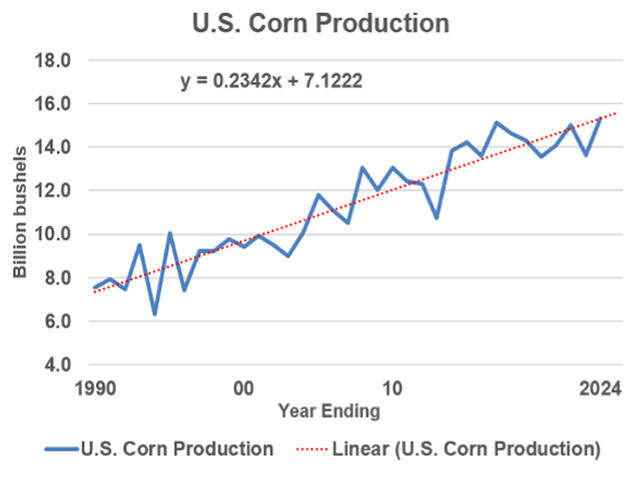Todd's Take
Another Way to Estimate 2024 US Corn, Soybean Crops
It's that time of year again, when we start estimating 2024 corn and soybean crops, prompted by USDA's Prospective Plantings report on March 28. Many of you know how the game goes. USDA's March survey is followed by its first new-crop estimates in the May WASDE report, followed by USDA's June 28 Acreage report. The Acreage report is followed by the first estimate of new-crop yields based on field data in September, followed by subsequent updates of yield and harvested acres that don't necessarily end in January. It's more of a ritual than reality to refer to USDA's January estimates as "final" estimates.
I was creating a chart of U.S. corn production the other day and was struck by how well-behaved the trend laid out. Since 1990, U.S. corn production has increased around both sides of a trend that has been steadily increasing 234 million bushels (mb) a year. Last year's final corn production total of 15.34 billion bushels (bb) was slightly above the trend at 15.32 bb. While we spent months chasing estimates of planted acres, yields and harvested acres in 2023, the best early estimate of last year's corn production was right under our nose the whole time -- the simple arithmetic trend of corn production.
Of course, USDA is obligated to stick by its traditional procedures and will follow its same course again this year, but while the chase is on, keep in mind if you are trying to guess the impact of weather, it is easier to work with one variable than three. A trend estimate is no substitute for actual evidence from the field, but it is a good starting point for thinking about what's normal.
P[L1] D[0x0] M[300x250] OOP[F] ADUNIT[] T[]
For 2024, the trend estimate of corn production is set at 15.55 bb and it should be no surprise weather will account for the biggest deviations. Corn production exceeded the trend by 1.52 bb in 1994-95 and undershot it by 1.99 bb in 2012-13, the two widest misses. Until USDA production estimates start to improve in October, the trend is a good reference to base weather-related adjustments from.
For soybeans, 2023 production was last estimated by USDA at 4.165 bb, 193 mb below the 4.36 bb trend. In 2024, the trend of U.S. soybean production reaches 4.43 bb, climbing 73.5 mb per year since 1990. That is not as high as USDA's production estimate of 4.505 bb from the Ag Outlook Forum in February but is a good starting point in the new season and suggests ending soybean stocks may be a little tighter than USDA anticipates for 2024-25. The two largest deviations of soybean production from trend happened within two years of each other. In 2017-18, soybean production overshot the trend by 495 mb and, after an extremely wet planting season in 2019-20, undershot the trend by 512 mb, a year in which planting was discouraged by the trade war with China.
As we embark on a new season of playing guess the crop size in 2024, I'll be curious to see what USDA comes up with, estimating all the separate pieces, as it traditionally does. Personally, I'll be paying attention to DTN weather assessments through the summer and will be content to base any adjustments off the production trends described above, leaving the guessing of yields and harvested acres to others. As I see it, until USDA's more accurate production estimates start arriving in October, the main goal of the early estimating process is to not get too far from reality. Production trends seem like a good tool for doing just that.
**
Comments above are for educational purposes only and are not meant as specific trade recommendations. The buying and selling of grain or grain futures or options involve substantial risk and are not suitable for everyone.
Todd Hultman can be reached at Todd.Hultman@dtn.com .
(c) Copyright 2024 DTN, LLC. All rights reserved.




